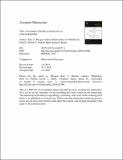Files in this item
Assessment of health in human faces is context-dependent
Item metadata
| dc.contributor.author | Morgan, Kate V. | |
| dc.contributor.author | Morton, Andrew | |
| dc.contributor.author | Whitehead, Ross D. | |
| dc.contributor.author | Perrett, David I. | |
| dc.contributor.author | Hurly, T. Andrew | |
| dc.contributor.author | Healy, Susan D. | |
| dc.date.accessioned | 2017-02-09T00:32:58Z | |
| dc.date.available | 2017-02-09T00:32:58Z | |
| dc.date.issued | 2016-04 | |
| dc.identifier | 240890689 | |
| dc.identifier | 69431c7f-759b-465a-9bd5-744079092040 | |
| dc.identifier | 84959222294 | |
| dc.identifier | 000373542900013 | |
| dc.identifier.citation | Morgan , K V , Morton , A , Whitehead , R D , Perrett , D I , Hurly , T A & Healy , S D 2016 , ' Assessment of health in human faces is context-dependent ' , Behavioural Processes , vol. 125 , pp. 89-95 . https://doi.org/10.1016/j.beproc.2016.02.006 | en |
| dc.identifier.issn | 0376-6357 | |
| dc.identifier.other | Bibtex: urn:f60efb3c6e3246fbd93d5ffdeb80dfd0 | |
| dc.identifier.other | ORCID: /0000-0002-8059-4480/work/60631280 | |
| dc.identifier.other | ORCID: /0000-0002-6025-0939/work/64360961 | |
| dc.identifier.uri | https://hdl.handle.net/10023/10253 | |
| dc.description | This work was supported by the National Environment Research Council, UK (KM), Unilever Research & Development USA and the Economic and Social Research Council (RW, DP). | en |
| dc.description.abstract | When making decisions between options, humans are expected to choose the option that returns the highest benefit. In practice, however, adding inferior alternatives to the choice set can alter these decisions. Here we investigated whether decisions over the facial features that people find healthy looking can also be affected by the context in which they see those faces. To do this we examined the effect of choice set on the perception of health of images of faces of light-skinned Caucasian females. We manipulated apparent facial health by changing yellowness of the skin: the healthy faces were moderately yellow and the less healthy faces were either much more yellow or much less yellow. In each experiment, two healthy faces were presented along with a third, less healthy face. When the third face was much more yellow, participants chose the more yellow of the two healthy faces more often as the most healthy. However, when the third face was the least yellow, participants chose the less yellow of the two healthy faces more often. A further experiment confirmed that this result is not due to a generalised preference for an intermediate option. These results extend our understanding of context-dependent decision-making in humans, and suggest that comparative evaluation may be a common feature across many different kinds of choices that humans have to make. | |
| dc.format.extent | 357829 | |
| dc.language.iso | eng | |
| dc.relation.ispartof | Behavioural Processes | en |
| dc.subject | Context-dependent choice | en |
| dc.subject | Health perception | en |
| dc.subject | Decision making | en |
| dc.subject | RC0321 Neuroscience. Biological psychiatry. Neuropsychiatry | en |
| dc.subject | QH301 Biology | en |
| dc.subject | NDAS | en |
| dc.subject | SDG 3 - Good Health and Well-being | en |
| dc.subject.lcc | RC0321 | en |
| dc.subject.lcc | QH301 | en |
| dc.title | Assessment of health in human faces is context-dependent | en |
| dc.type | Journal article | en |
| dc.contributor.institution | University of St Andrews. School of Biology | en |
| dc.contributor.institution | University of St Andrews. School of Psychology and Neuroscience | en |
| dc.contributor.institution | University of St Andrews. School of Medicine | en |
| dc.contributor.institution | University of St Andrews. Child and Adolescent Health Research Unit | en |
| dc.contributor.institution | University of St Andrews. Institute of Behavioural and Neural Sciences | en |
| dc.contributor.institution | University of St Andrews. Centre for Social Learning & Cognitive Evolution | en |
| dc.contributor.institution | University of St Andrews. Centre for Biological Diversity | en |
| dc.identifier.doi | https://doi.org/10.1016/j.beproc.2016.02.006 | |
| dc.description.status | Peer reviewed | en |
| dc.date.embargoedUntil | 2017-02-08 |
This item appears in the following Collection(s)
Items in the St Andrews Research Repository are protected by copyright, with all rights reserved, unless otherwise indicated.

